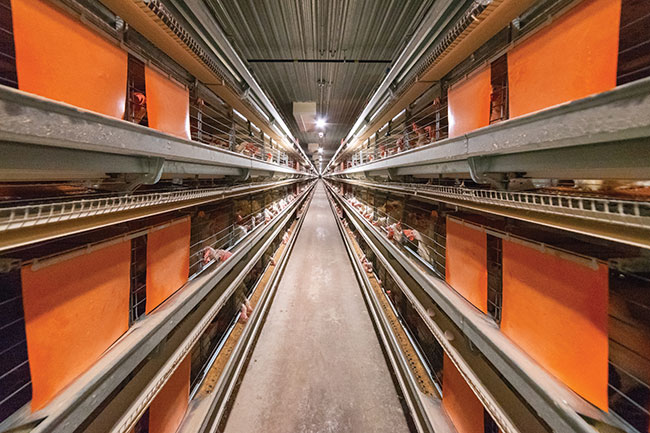
5 tips for operating an enriched system
By Ron Wardrop
Features Barn ManagementManagement practices to get the most out of furnished cages.
 Controlling the movement of the eggs in the system and on the collection belts will help with egg quality. PHOTO CREDIT: Big Dutchman
Controlling the movement of the eggs in the system and on the collection belts will help with egg quality. PHOTO CREDIT: Big Dutchman
As the regulations quickly change – the layer industry is mandated to move towards alternative style housing – it’s important to understand that there are many differences between these newer systems and conventional housing. Some of these offer advantages, such as being a safe and humane replacement for conventional housing environments.
Take enriched cages, for example. Although similar to the conventional cages, they give birds more space to express natural behaviours and encourage them to lay their eggs in a nest area. However, these traits can also present management challenges. Producers need to overcome these obstacles to maximize egg quality by using management practices specific to the enriched housing.
1. Nest placement
The placement of the cage enrichments is very important to the long-term success of the operation. The most important of these being the nest area, which should be at the front of the cage closest to the egg belt and be kept dark and placed in a calm area (like a corner). This will ensure the eggs don’t have to roll through a high traffic area to get onto the egg belt where they could get pecked, stepped on or become dirty, making them unsaleable.
As well, the nest curtains should be close to the floor to control the light entering the nest. Darkness will increase nest acceptance and decrease mis-laid eggs. The scratch pad should be placed away from the nest, as it will excite the hens and disturb the laying process.
2. Lighting
Enriched cages are a package system with the enhancements working together to achieve an overall positive experience for the hens. A big part of the functionality is the lighting of the cages. The best results come from the lighting being inside the system for direct control of the intensity and consistency in every cage. Direct control also allows the nest area to remain dark, which increases nest acceptance and, as a result, improves egg quality.
3. Nest pad maintenance
Nest pads are an important enhancement to the enriched system for hen comfort. However, they do require regular maintenance. Inspecting the nest pads on a weekly basis and removing excess debris build up will cut down on dirty eggs. In extreme cases, these build ups can stop eggs from reaching the egg belt and increasing the chance of damage.
4. Feeding
Having a feeding program becomes part of the management of the alternative layer system. Feeding shouldn’t interrupt the egg laying process. This will increase eggs being laid in the nests.
Running the feed system during the egg laying time will disturb the hens and draw the birds out of the nest, which leads to mislaid eggs.
Experts suggest that feed run when the lights are first turned on and then not again until after the peak laying period is over and equally through the rest of the day. This schedule will lead to the birds laying more eggs in the nest, experts say.
As well, ensure that any feed and water sources that can be reached from the nest area is blocked because you don’t want birds encouraged to stay in the nest area.
5. Egg control
Controlling the movement of the eggs in the system and on the collection belts will help with egg quality. Most enriched systems have built in programming of the egg belt movement, allowing it to run on a schedule. By moving the egg belts frequently, the length of the nest area, you will keep eggs from overcrowding on the egg belt and crashing into each other, causing damage. This program can be set in your control system and is vital to stopping cracked and checked eggs.
Another tool in the control of egg belt density is the use of the egg saver wire. This will help cushion the eggs before they roll onto the egg belt, lessening the impact into other eggs.
Also important is ensuring that equal numbers of birds have access to each side of the collection system. This is done by adding a center divider in the cage so you ensure that equal eggs are deposited on each side’s egg belts. Doing this will prevent belt overcrowding, as sometimes birds prefer a nest side and can overwhelm the collection system on that side. Adding the divider ensures that equal numbers use the collection systems.
If you adopt these simple ideas, you’ll successfully adapt to an enriched system. I know there are many more things that make a successful layer farm. But these, I feel, are the simple items that will help move toward success.
Some equipment manufacturers have bird behavioural specialists on staff to help with the startup and operation of enriched equipment for the novice user. I encourage you to use them to ease the transition and make the conversion experience a success from the very first flock.
Ron Wardrop is regional sale manager, Canada, with Big Dutchman.
Print this page